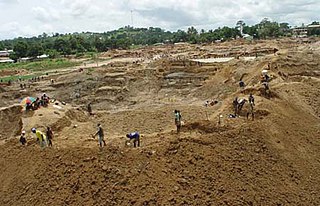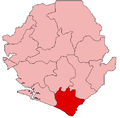The demographics of Sierra Leone are made up of an indigenous population from 18 ethnic groups. The Temne in the north and the Mende in the South are the largest. About 60,000 are Krio, the descendants of freed slaves who returned to Sierra Leone from Great Britain, North America and slave ships captured on the high seas. In addition, about 5,000 Lebanese, 1,000 Indians, and 5,000 Europeans reside in the country.

The economy of Sierra Leone is that of a least developed country with a GDP of approximately 1.9 billion USD in 2009. Since the end of the civil war in 2002 the economy is gradually recovering with a GDP growth rate between 4 and 7%. In 2008 its GDP in PPP ranked between 147th and 153rd (CIA) largest in the world.
Telecommunications in Sierra Leone include radio, television, fixed and mobile telephones, and the Internet.

Freetown is the capital and largest city of Sierra Leone. It is a major port city on the Atlantic Ocean and is located in the Western Area of the country. Freetown is Sierra Leone's major urban, economic, financial, cultural, educational and political centre, as it is the seat of the Government of Sierra Leone. The population of Freetown was 1,055,964 at the 2015 census.

The provinces of Sierra Leone are divided into 16 districts, as of July 2017. Previously, the country was divided into 14 districts. The Western Area is divided into two districts. Sierra Leone's capital Freetown is located in the Western Area of the country and its makes up the Western Area Urban District.

Bo, also commonly referred to as Bo Town, is the third largest city in Sierra Leone by population and the largest city in the Southern Province. Bo is the capital and administrative center of Bo District. The city of Bo had a population of 149,957 in the 2004 census and had population of about 175,000, based on the 2015 national census. Bo is an urban center, and lies approximately 160 miles east south-east of Freetown, and about 44 miles (71 km) to Kenema. Bo is the leading financial, educational and economic center of Southern Sierra Leone. Bo was previously the second largest city in Sierra Leone by population, However, Kenema over took Bo in population after the 2015 Sierra Leone national census.

Makeni is the largest city in the Northern Province of Sierra Leone. The city is the capital of Bombali District, and is the economic center of the Northern Province. Makeni is the fifth largest city in Sierra Leone by population. The city of Makeni had a population of 80,840 in the 2004 census and a 2015 estimate of 125,970. Makeni lies approximately 137 kilometers east of Freetown.

The Southern Province is one of the four provinces of Sierra Leone. It covers an area of 19,694 km² and has a population of 1,438,572. It consists of four districts. Its capital and administrative center is Bo, which is also the second largest and second most populated city in Sierra Leone after the nation's capital Freetown. The population of the southern province is largely from the Mende ethnic group.

The Northern Province is one of the five provincial divisions of Sierra Leone. It is located in the Northern geographic region of Sierra Leone. It comprises the following four Districts: Bombali, Falaba, Koinadugu and Tonkolili. The Northern Province covers an area of 35,936 km2 (13,875 sq mi) with a population of 2,502,865, based on the 2015 Sierra Leone national census. Its administrative and economic center is Makeni. The North borders the Western Area to the West, the Republic of Guinea to the north-east, the Eastern Province and Southern Province to the south-east.

Islam is the largest and majority religion in Sierra Leone. Based on the 2015 Pew Research Center research, 78℅ of Sierra Leone's population is Muslim.

Kono District is a diamond-rich district in the Eastern Province of Sierra Leone. Its capital and largest city is Koidu Town. Motema is the second most populous city in the district. The other major towns in the district include Yengema, Tombodu, Jaiama Nimikor and Sewafe. The district is the largest diamond producer in Sierra Leone. The population of Kono District is 505,767. Kono District borders Kenema District to the southwest, The Republic of Guinea to the east, Koinadugu District to the northeast and Kailahun District to the southeast. Kono District is divided into fourteen chiefdoms
In terms of available healthcare and health status Sierra Leone is rated very poorly. Globally, infant and maternal mortality rates remain among the highest. The major causes of illness within the country are preventable with modern technology and medical advances. Most deaths within the country are attributed to nutritional deficiencies, lack of access to clean water, pneumonia, diarrheal diseases, anemia, malaria, tuberculosis and HIV/AIDS.

The following outline is provided as an overview of and topical guide to Sierra Leone:

Sierra Leone was a sovereign state with Queen Elizabeth II as its head of state between independence on 27 April 1961 and becoming the Republic of Sierra Leone on 19 April 1971.

Sierra Leone is officially a secular state, although Islam and Christianity are the two main and dominant religions in the country. The constitution of Sierra Leone provides for freedom of religion and the Sierra Leone Government generally protects it. The Sierra Leone Government is constitutionally forbidden from establishing a state religion, though Muslim and Christian prayers are usually held in the country at the beginning of major political occasions, including presidential inauguration.
Sierra Leone is a multilingual country. English is the de facto official language, and Krio is the most widely spoken.

Sierra Leone is home to about sixteen ethnic groups, each with its own language. In Sierra Leone, membership of an ethnic group often overlaps with a shared religious identity.

The Sierra Leone Colony and Protectorate was the British colonial administration in Sierra Leone from 1808 to 1961, part of the British Empire from the abolitionism era until the decolonisation era. The Crown colony, which included the area surrounding Freetown, was established in 1808. The protectorate was established in 1896 and included the interior of what is today known as Sierra Leone.

Israel–Sierra Leone relations are the official and diplomatic relations between the State of Israel and the west African Republic of Sierra Leone. Both nations have friendly ties, established in 1961 when Sierra Leone gained independence. Israel has no embassy in Freetown, and is represented through its embassy in Senegal. Likewise, Sierra Leone does not maintain a diplomatic representation in Israel, and is instead represented by its consul of honor, Israeli media personality David Ben Basat.















